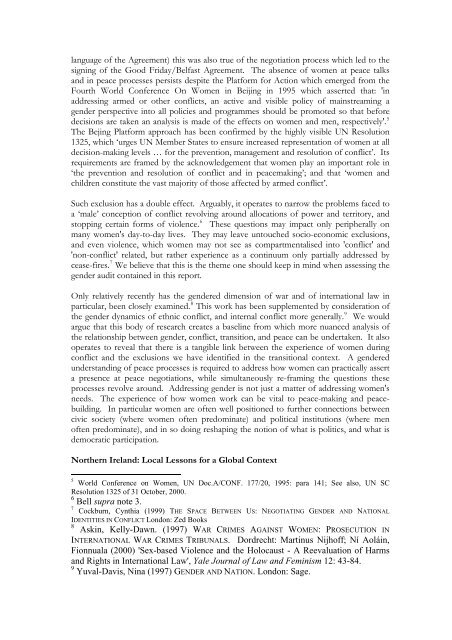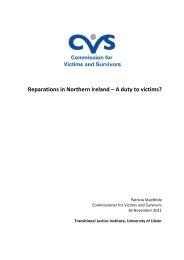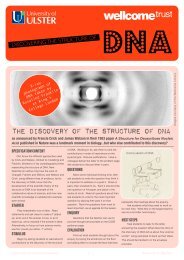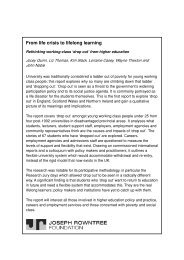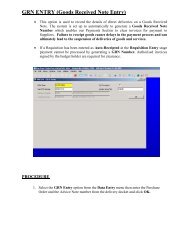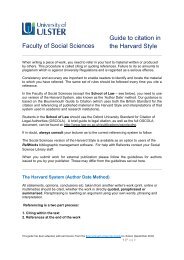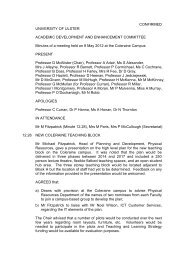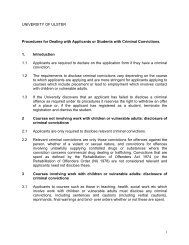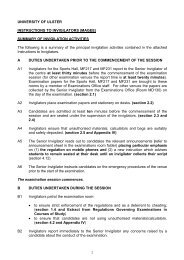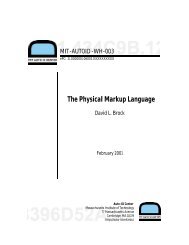Agreement Reached in the Multi-Party Negotiations - Transitional ...
Agreement Reached in the Multi-Party Negotiations - Transitional ...
Agreement Reached in the Multi-Party Negotiations - Transitional ...
You also want an ePaper? Increase the reach of your titles
YUMPU automatically turns print PDFs into web optimized ePapers that Google loves.
language of <strong>the</strong> <strong>Agreement</strong>) this was also true of <strong>the</strong> negotiation process which led to <strong>the</strong><br />
sign<strong>in</strong>g of <strong>the</strong> Good Friday/Belfast <strong>Agreement</strong>. The absence of women at peace talks<br />
and <strong>in</strong> peace processes persists despite <strong>the</strong> Platform for Action which emerged from <strong>the</strong><br />
Fourth World Conference On Women <strong>in</strong> Beij<strong>in</strong>g <strong>in</strong> 1995 which asserted that: '<strong>in</strong><br />
address<strong>in</strong>g armed or o<strong>the</strong>r conflicts, an active and visible policy of ma<strong>in</strong>stream<strong>in</strong>g a<br />
gender perspective <strong>in</strong>to all policies and programmes should be promoted so that before<br />
decisions are taken an analysis is made of <strong>the</strong> effects on women and men, respectively'. 5<br />
The Bej<strong>in</strong>g Platform approach has been confirmed by <strong>the</strong> highly visible UN Resolution<br />
1325, which ‘urges UN Member States to ensure <strong>in</strong>creased representation of women at all<br />
decision-mak<strong>in</strong>g levels … for <strong>the</strong> prevention, management and resolution of conflict’. Its<br />
requirements are framed by <strong>the</strong> acknowledgement that women play an important role <strong>in</strong><br />
‘<strong>the</strong> prevention and resolution of conflict and <strong>in</strong> peacemak<strong>in</strong>g’; and that ‘women and<br />
children constitute <strong>the</strong> vast majority of those affected by armed conflict’.<br />
Such exclusion has a double effect. Arguably, it operates to narrow <strong>the</strong> problems faced to<br />
a ‘male’ conception of conflict revolv<strong>in</strong>g around allocations of power and territory, and<br />
stopp<strong>in</strong>g certa<strong>in</strong> forms of violence. 6 These questions may impact only peripherally on<br />
many women's day-to-day lives. They may leave untouched socio-economic exclusions,<br />
and even violence, which women may not see as compartmentalised <strong>in</strong>to 'conflict' and<br />
'non-conflict' related, but ra<strong>the</strong>r experience as a cont<strong>in</strong>uum only partially addressed by<br />
cease-fires. 7 We believe that this is <strong>the</strong> <strong>the</strong>me one should keep <strong>in</strong> m<strong>in</strong>d when assess<strong>in</strong>g <strong>the</strong><br />
gender audit conta<strong>in</strong>ed <strong>in</strong> this report.<br />
Only relatively recently has <strong>the</strong> gendered dimension of war and of <strong>in</strong>ternational law <strong>in</strong><br />
particular, been closely exam<strong>in</strong>ed. 8 This work has been supplemented by consideration of<br />
<strong>the</strong> gender dynamics of ethnic conflict, and <strong>in</strong>ternal conflict more generally. 9 We would<br />
argue that this body of research creates a basel<strong>in</strong>e from which more nuanced analysis of<br />
<strong>the</strong> relationship between gender, conflict, transition, and peace can be undertaken. It also<br />
operates to reveal that <strong>the</strong>re is a tangible l<strong>in</strong>k between <strong>the</strong> experience of women dur<strong>in</strong>g<br />
conflict and <strong>the</strong> exclusions we have identified <strong>in</strong> <strong>the</strong> transitional context. A gendered<br />
understand<strong>in</strong>g of peace processes is required to address how women can practically assert<br />
a presence at peace negotiations, while simultaneously re-fram<strong>in</strong>g <strong>the</strong> questions <strong>the</strong>se<br />
processes revolve around. Address<strong>in</strong>g gender is not just a matter of address<strong>in</strong>g women's<br />
needs. The experience of how women work can be vital to peace-mak<strong>in</strong>g and peacebuild<strong>in</strong>g.<br />
In particular women are often well positioned to fur<strong>the</strong>r connections between<br />
civic society (where women often predom<strong>in</strong>ate) and political <strong>in</strong>stitutions (where men<br />
often predom<strong>in</strong>ate), and <strong>in</strong> so do<strong>in</strong>g reshap<strong>in</strong>g <strong>the</strong> notion of what is politics, and what is<br />
democratic participation.<br />
Nor<strong>the</strong>rn Ireland: Local Lessons for a Global Context<br />
5<br />
World Conference on Women, UN Doc.A/CONF. 177/20, 1995: para 141; See also, UN SC<br />
Resolution 1325 of 31 October, 2000.<br />
6<br />
Bell supra note 3.<br />
7<br />
Cockburn, Cynthia (1999) THE SPACE BETWEEN US: NEGOTIATING GENDER AND NATIONAL<br />
IDENTITIES IN CONFLICT London: Zed Books<br />
8<br />
Ask<strong>in</strong>, Kelly-Dawn. (1997) WAR CRIMES AGAINST WOMEN: PROSECUTION IN<br />
INTERNATIONAL WAR CRIMES TRIBUNALS. Dordrecht: Mart<strong>in</strong>us Nijhoff; Ní Aolá<strong>in</strong>,<br />
Fionnuala (2000) 'Sex-based Violence and <strong>the</strong> Holocaust - A Reevaluation of Harms<br />
and Rights <strong>in</strong> International Law', Yale Journal of Law and Fem<strong>in</strong>ism 12: 43-84.<br />
9<br />
Yuval-Davis, N<strong>in</strong>a (1997) GENDER AND NATION. London: Sage.


